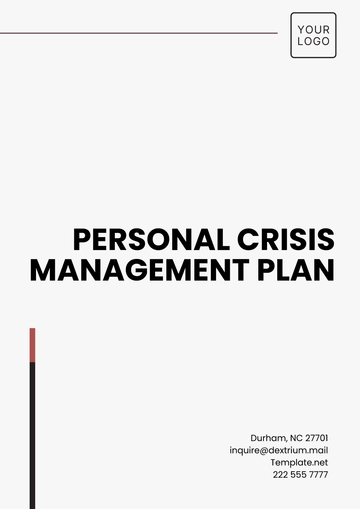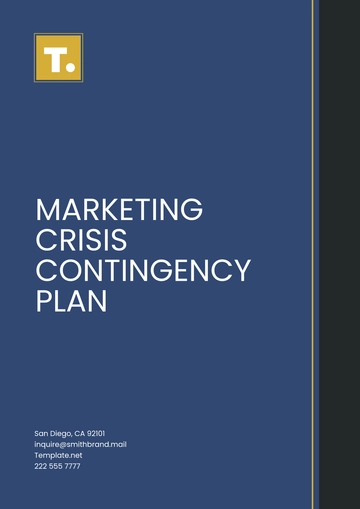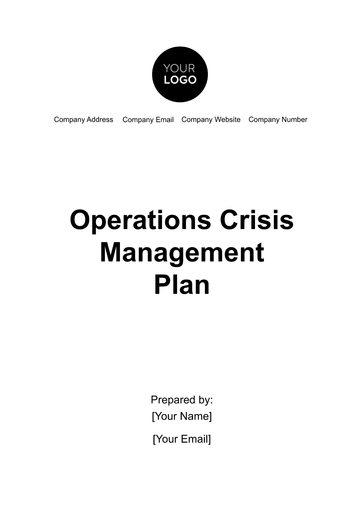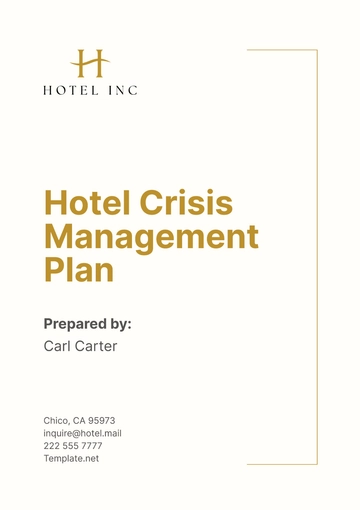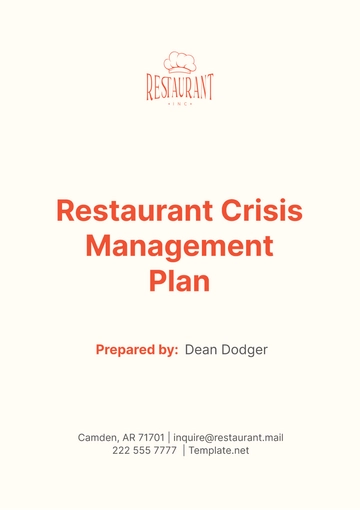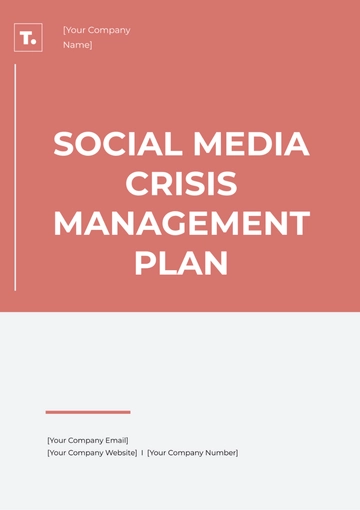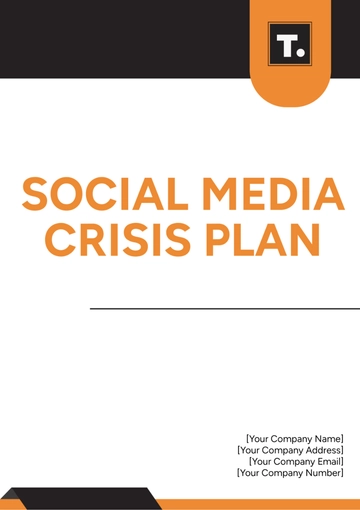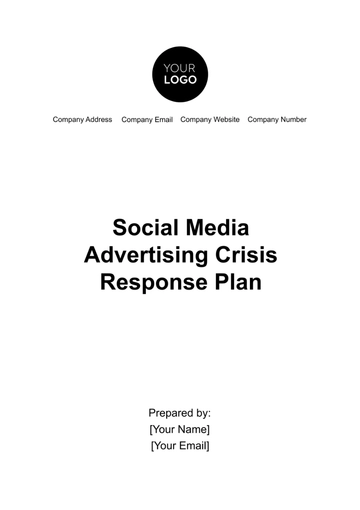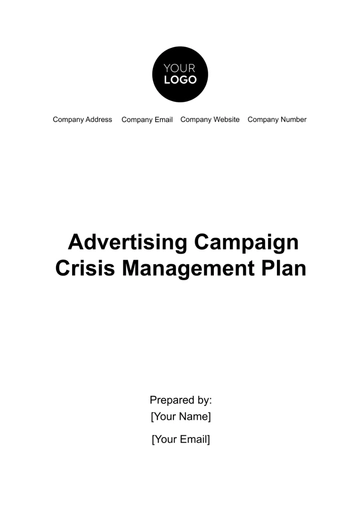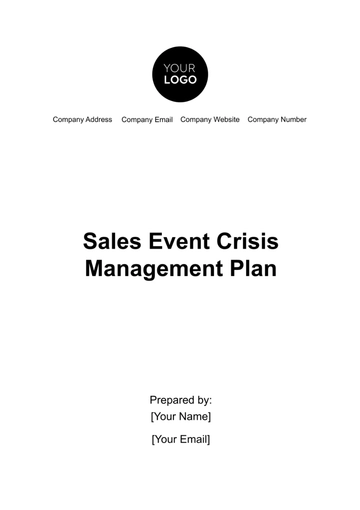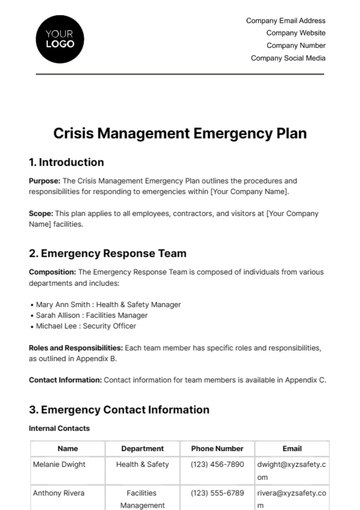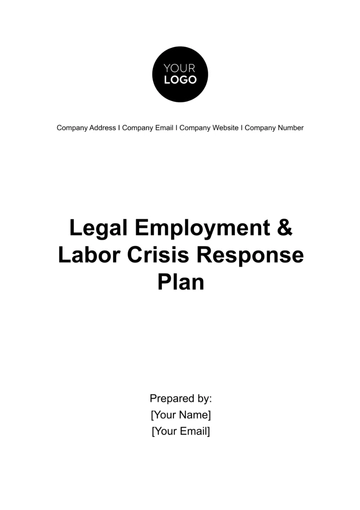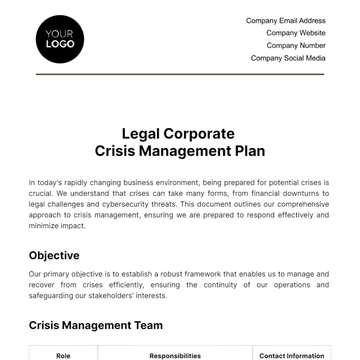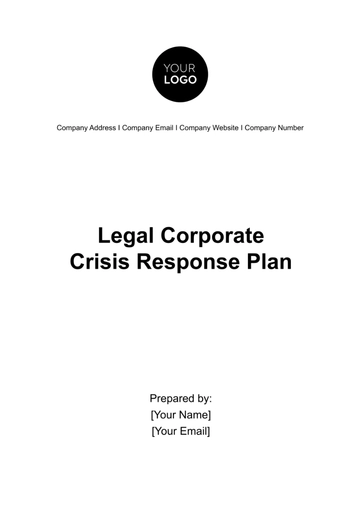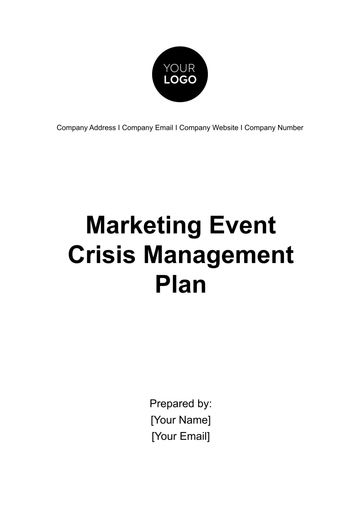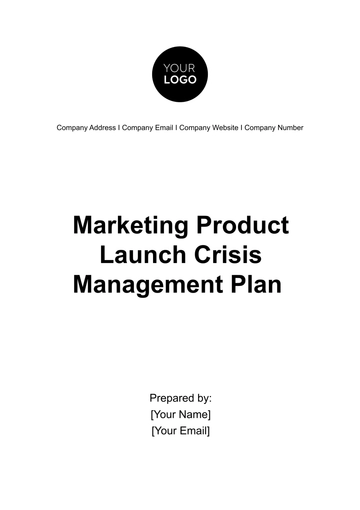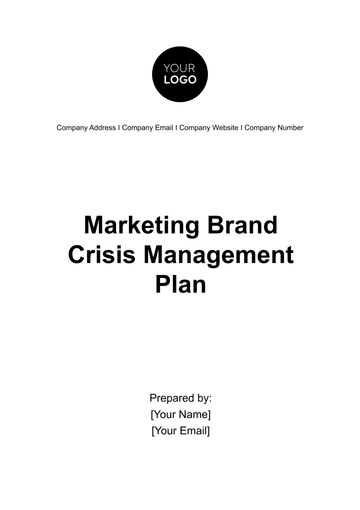Free Advertising Campaign Crisis Management Plan
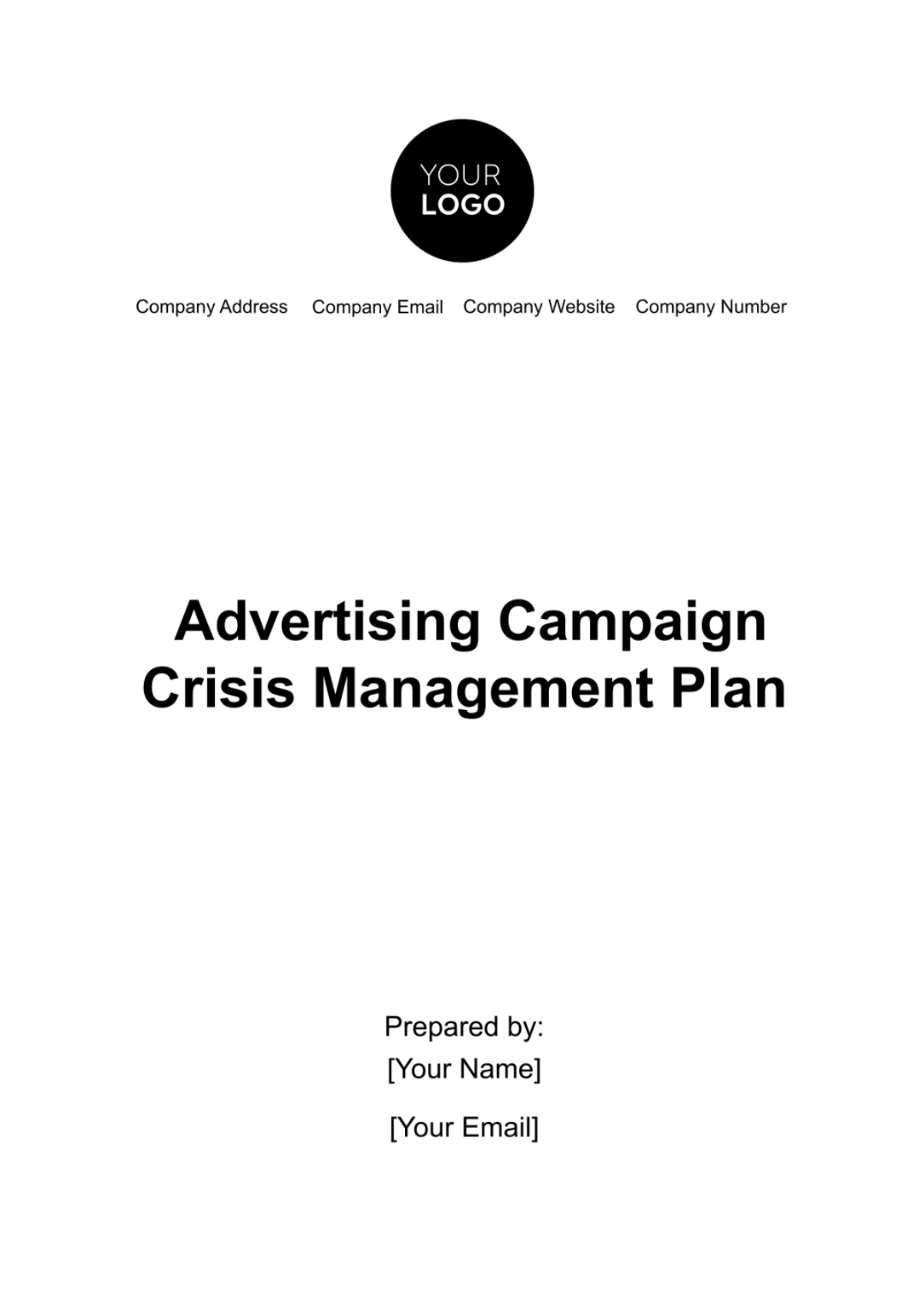
Management Plan
I. Introduction
This document serves as a comprehensive guide for managing crises that may arise during social media advertising campaigns. The goal is to minimize damage, maintain brand integrity, and ensure a swift return to normal operations. Effective crisis management is vital in preserving customer trust and the company's reputation.
II. Crisis Management Team
The composition and key roles are outlined in the following table:
Role | Responsibilities | Contact Information |
Team Lead | Coordination and oversight | [Team Lead Email/Phone] |
Legal Advisor | Legal guidance and compliance | [Legal Advisor Email/Phone] |
PR Specialist | Public relations and communication | [PR Specialist Email/Phone] |
Social Media Manager | Social media monitoring and response | [Social Media Manager Email/Phone] |
IT Specialist | Technical support and cybersecurity | [IT Specialist Email/Phone] |
The Team Lead Acts as the central point of contact, coordinating the team's efforts and decision-making processes. The Legal Advisor evaluates the legal implications of the crisis and advises on compliance matters.
The PR Specialist develops communication strategies to address public concerns and maintain brand image. The Social Media Manager monitors social media trends and engagement to gauge public sentiment and response. Additionally the IT Specialist ensures the security and functionality of digital platforms during the crisis.
III. Crisis Identification
Effective crisis identification is pivotal for timely and appropriate responses. The following table presents the indicators, criteria and alert level:
Indicator | Criteria | Alert Level |
Negative Social Media Engagement | >20% increase in negative comments/mentions in 24 hours | High |
Media Coverage | Multiple negative media reports within a 48-hour period | Medium |
Customer Feedback | Sudden surge in negative customer feedback or complaints | High |
Legal/Regulatory Notices | Receipt of any legal or regulatory notice related to the campaign | Immediate Action |
This involves continuous monitoring and analysis of various indicators, including social media sentiment, media coverage, and customer feedback. The team should employ advanced monitoring tools to track relevant keywords, brand mentions, and sentiment trends in real-time.
The Advanced Monitoring Tools involves leveraging AI-driven tools like Sprinklr for deeper insights into public sentiment and emerging trends.
Criteria for Crisis Recognition includes setting specific metrics for negative engagement (e.g., a sudden 20% increase in negative sentiment) and establishing protocols for immediate notification of the crisis team.
IV. Crisis Response Strategy
The initial response to a crisis is crucial. The strategy should include a quick acknowledgment of the situation, ensuring the public that the matter is being taken seriously. Gathering facts is essential to avoid miscommunication. The crisis team should work closely to formulate a response that is accurate, empathetic, and aligns with the company's values.
A. Rapid Response Framework
Developing a structured response protocol to guide the team through the first 24-48 hours of the crisis:
Timeframe | Action | Responsibility |
0-2 hours | Acknowledge the issue publicly, confirm ongoing investigation | PR Specialist |
2-4 hours | Gather all relevant facts and data related to the issue | Crisis Management Team |
4-24 hours | Issue official statement with initial findings and actions | PR Specialist & Team Lead |
24-48 hours | Update internal and external stakeholders on developments | Team Lead |
B. Stakeholder Engagement
Identifying key stakeholders (e.g., customers, partners, investors) and tailoring communication to address their concerns:
Stakeholder | Method of Engagement | Frequency/ Trigger |
Customers | Social media updates, dedicated FAQ page | As developments occur |
Employees | Internal memos, intranet announcements | Daily updates during crisis |
Investors/ Shareholders | Email updates, conference calls | Weekly or as needed |
Media | Press releases, press conferences | As significant updates occur |
V. Action Plan
Immediate actions include pausing campaigns that might exacerbate the situation and conducting a thorough review of what triggered the crisis. It’s important to communicate internally to ensure that all employees are informed and aligned. Long-term actions focus on learning from the crisis and implementing changes to prevent future occurrences.
A. Risk Assessment and Mitigation
Conducting a detailed risk assessment to understand the full scope of the crisis and developing mitigation strategies:
Risk Factor | Assessment Method | Mitigation Strategy |
Brand Reputation | Media sentiment analysis and customer surveys | Targeted PR campaigns |
Legal Compliance | Consultation with legal team | Adherence to legal advice |
Operational Disruption | Analysis of campaign performance metrics | Contingency planning |
B. Feedback Loop
Establishing a feedback mechanism to gather insights from employees, customers, and other stakeholders for continuous improvement:
Source | Method of Collection | Utilization |
Customers | Surveys, social media monitoring | Campaign adjustments |
Employees | Internal feedback forms, town hall meetings | Operational improvements |
Industry Experts | Consultations, benchmarking against best practices | Strategic insights |
VI. Crisis Recovery
Post-crisis, the focus shifts to rebuilding the brand's reputation and trust with the audience. This involves transparent communication about the steps taken to address the issue and prevent future crises. Engaging in community initiatives or CSR activities can also aid in restoring brand image.
A. Brand Rehabilitation Initiatives
Implementing specific campaigns aimed at brand rehabilitation, such as community outreach programs or transparency reports.
Initiative | Description | Expected Outcome |
Community Outreach | Participation in or sponsorship of community events | Improved public perception |
Transparency Reporting | Regular updates on steps taken post-crisis | Trust rebuilding |
Customer Engagement | Interactive campaigns to re-engage customers | Customer loyalty restoration |
B. Long-term Monitoring
Continuously monitoring public sentiment post-crisis to gauge recovery progress and adjust strategies as needed:
Aspect | Monitoring Tool | Frequency |
Public Sentiment | Social media analytics platforms (e.g., Hootsuite) | Weekly |
Media Coverage | Media monitoring services (e.g., Meltwater) | Bi-weekly |
Campaign Performance | Internal analytics tools | Monthly |
VII. Training and Simulation
Regular training ensures that the crisis management team is always prepared. These sessions should include simulations of various crisis scenarios, ranging from minor issues to major controversies. Learning from real-world cases and adapting those lessons into training exercises can significantly improve the team's readiness and response effectiveness.
A. Scenario-based Training
Creating realistic crisis scenarios based on potential risks identified in the company's operations and industry trends:
Scenario | Description | Training Frequency |
Social Media Backlash | Negative viral trend on social media | Quarterly |
Legal Challenge | Hypothetical legal issue related to advertising | Bi-annually |
Data Breach | Simulated cybersecurity incident impacting campaign data | Annually |
B. Continuous Learning
Incorporating lessons learned from past crises (both internal and external) into training modules to enhance preparedness:
Component | Method | Update Frequency |
Industry Trends | Subscription to industry reports, attending seminars | Monthly |
Past Crisis Reviews | Post-crisis analysis and debriefings | After every major crisis |
Employee Feedback | Regular surveys and suggestion boxes | Quarterly |
VIII. Legal and Regulatory Compliance
The company emphasizes the importance of staying compliant with legal standards and regulations. It involves regular audits, staff training, and close collaboration with legal experts to ensure that all advertising campaigns adhere to the necessary legal and ethical standards:
Aspect | Description | Action Steps |
Advertising Standards | Adherence to national and international advertising standards | Regular audits and training |
Consumer Protection Laws | Compliance with consumer rights and privacy laws | Legal consultations and policy updates |
Social Media Policies | Understanding and following each platform's advertising policies | Continuous review and updates |
IX. Digital Security and Data Protection
In the digital age, protecting digital assets and customer data is paramount. The company addresses the need for robust cybersecurity measures and data privacy practices. It includes implementing advanced security protocols and conducting regular data audits to prevent and respond to any potential data breaches:
Aspect | Strategy | Implementation |
Cybersecurity Measures | Implementation of advanced security protocols | IT department oversight |
Data Privacy | Adherence to data protection laws and best practices | Regular data audits |
Crisis Response for Data Breaches | Established protocols for responding to data breaches | Simulated breach exercises |
X. Conclusion
This crisis management plan is a dynamic document designed to guide the organization through potential crises in the digital advertising landscape. It emphasizes proactive monitoring, rapid response, legal compliance, digital security, and continuous learning. Regular reviews and updates to the plan are critical to ensure it remains effective in an ever-evolving digital environment. The commitment to continuous improvement, staff training, and adherence to ethical standards is essential for maintaining the trust and loyalty of customers and stakeholders. By following this comprehensive plan, the organization can navigate through crises with confidence and integrity, ensuring long-term success and resilience in its advertising efforts.
- 100% Customizable, free editor
- Access 1 Million+ Templates, photo’s & graphics
- Download or share as a template
- Click and replace photos, graphics, text, backgrounds
- Resize, crop, AI write & more
- Access advanced editor
Be prepared for any campaign crisis with ease with our Advertising Campaign Crisis Management Plan Template made available for you on Template.net! This customizable and editable plan, allowing you to create a detailed crisis management plan. The AI Editor Tool simplifies the editing process, helping you handle any crisis effectively!
You may also like
- Finance Plan
- Construction Plan
- Sales Plan
- Development Plan
- Career Plan
- Budget Plan
- HR Plan
- Education Plan
- Transition Plan
- Work Plan
- Training Plan
- Communication Plan
- Operation Plan
- Health And Safety Plan
- Strategy Plan
- Professional Development Plan
- Advertising Plan
- Risk Management Plan
- Restaurant Plan
- School Plan
- Nursing Home Patient Care Plan
- Nursing Care Plan
- Plan Event
- Startup Plan
- Social Media Plan
- Staffing Plan
- Annual Plan
- Content Plan
- Payment Plan
- Implementation Plan
- Hotel Plan
- Workout Plan
- Accounting Plan
- Campaign Plan
- Essay Plan
- 30 60 90 Day Plan
- Research Plan
- Recruitment Plan
- 90 Day Plan
- Quarterly Plan
- Emergency Plan
- 5 Year Plan
- Gym Plan
- Personal Plan
- IT and Software Plan
- Treatment Plan
- Real Estate Plan
- Law Firm Plan
- Healthcare Plan
- Improvement Plan
- Media Plan
- 5 Year Business Plan
- Learning Plan
- Marketing Campaign Plan
- Travel Agency Plan
- Cleaning Services Plan
- Interior Design Plan
- Performance Plan
- PR Plan
- Birth Plan
- Life Plan
- SEO Plan
- Disaster Recovery Plan
- Continuity Plan
- Launch Plan
- Legal Plan
- Behavior Plan
- Performance Improvement Plan
- Salon Plan
- Security Plan
- Security Management Plan
- Employee Development Plan
- Quality Plan
- Service Improvement Plan
- Growth Plan
- Incident Response Plan
- Basketball Plan
- Emergency Action Plan
- Product Launch Plan
- Spa Plan
- Employee Training Plan
- Data Analysis Plan
- Employee Action Plan
- Territory Plan
- Audit Plan
- Classroom Plan
- Activity Plan
- Parenting Plan
- Care Plan
- Project Execution Plan
- Exercise Plan
- Internship Plan
- Software Development Plan
- Continuous Improvement Plan
- Leave Plan
- 90 Day Sales Plan
- Advertising Agency Plan
- Employee Transition Plan
- Smart Action Plan
- Workplace Safety Plan
- Behavior Change Plan
- Contingency Plan
- Continuity of Operations Plan
- Health Plan
- Quality Control Plan
- Self Plan
- Sports Development Plan
- Change Management Plan
- Ecommerce Plan
- Personal Financial Plan
- Process Improvement Plan
- 30-60-90 Day Sales Plan
- Crisis Management Plan
- Engagement Plan
- Execution Plan
- Pandemic Plan
- Quality Assurance Plan
- Service Continuity Plan
- Agile Project Plan
- Fundraising Plan
- Job Transition Plan
- Asset Maintenance Plan
- Maintenance Plan
- Software Test Plan
- Staff Training and Development Plan
- 3 Year Plan
- Brand Activation Plan
- Release Plan
- Resource Plan
- Risk Mitigation Plan
- Teacher Plan
- 30 60 90 Day Plan for New Manager
- Food Safety Plan
- Food Truck Plan
- Hiring Plan
- Quality Management Plan
- Wellness Plan
- Behavior Intervention Plan
- Bonus Plan
- Investment Plan
- Maternity Leave Plan
- Pandemic Response Plan
- Succession Planning
- Coaching Plan
- Configuration Management Plan
- Remote Work Plan
- Self Care Plan
- Teaching Plan
- 100-Day Plan
- HACCP Plan
- Student Plan
- Sustainability Plan
- 30 60 90 Day Plan for Interview
- Access Plan
- Site Specific Safety Plan
